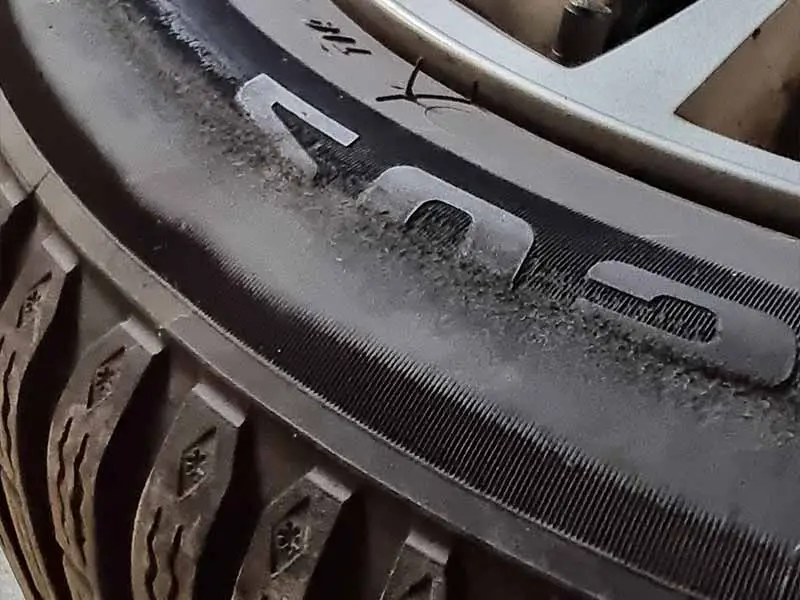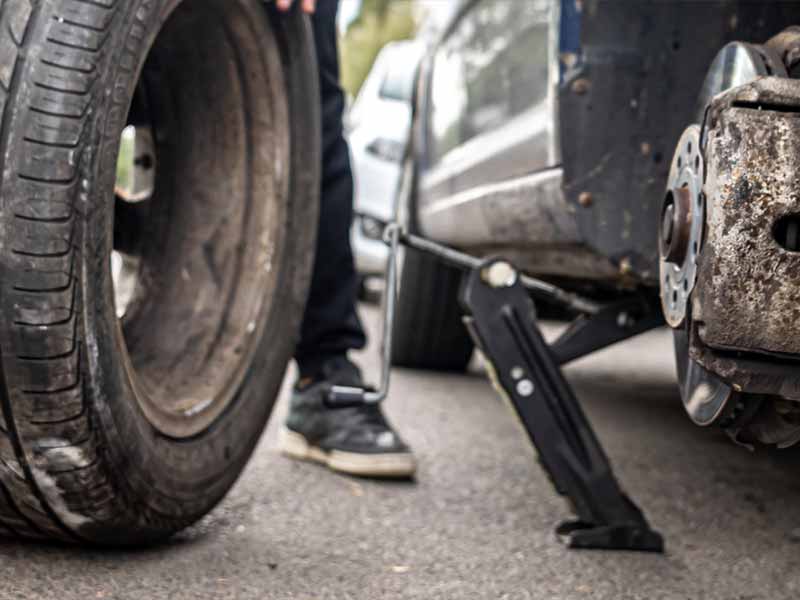Picture this: you’re on a quiet road, miles from the nearest town, and your tire goes flat. A sinking feeling hits you, but then you remember – you have a can of Fix-a-Flat in your trunk!
Relief washes over you, but now a crucial question pops up: once you’ve applied Fix-a-Flat, how long do you need to wait before you can get back on the road and drive to the nearest tire shop?
How Long Does Fix-A-Flat Take To Harden?
Fix-a-Flat takes about 10 minutes to harden and seal a small puncture in your tire, although the exact time can vary depending on the size of the hole and the environmental conditions.
In this article, we’re going to explore everything you need to know about Fix-a-Flat – from understanding what it is and how to use it, to learning about the hardening process, how long it lasts in a tire, and finally, how to handle inflating your tire after using Fix-a-Flat.
Let’s take a closer look.

What Is Fix-a-Flat?
Alright, let’s get into the nitty-gritty about a handy-dandy tool for flat tires – the Fix-a-Flat. This neon green can is a lifeline when you’re stranded on the side of the road with a flat tire. But remember, it’s not some magic potion – it’s a quick, temporary solution to get you rolling again until you can get a proper tire repair. Here’s what you need to know.
Definition and Function of Fix-a-Flat
Fix-a-Flat is basically a can of aerosol tire sealant. The contents are designed to inflate your tire and seal small punctures so that you can drive to the nearest tire shop for a proper repair.
- Inflate: When you’re dealing with a flat tire, getting some air back in it is crucial. Fix-a-Flat uses a propellant to pump air back into your tire.
- Seal: Fix-a-Flat also includes a sealant that plugs the hole causing the flat. This gives you enough time to seek out a professional tire repair.
Temporary Solution, Not Permanent Fix
It’s super important to remember that Fix-a-Flat is not a permanent solution. Think of it as a band-aid for your tire. It helps you in an emergency, but you should still get the tire properly fixed or replaced as soon as you can. If you keep driving on a tire fixed with Fix-a-Flat, you might face:
- Uneven Tire Wear: Because the sealant is heavier than air, it might cause an imbalance in your tire. This can lead to uneven tire wear, and ultimately, a shorter tire life.
- Damage to Tire Pressure Monitoring System: Some types of Fix-a-Flat can gum up your tire pressure monitoring system, making it harder to keep track of your tire pressure.

Fix-A-Flat
Using Fix-a-Flat: Step by Step
Alright, now that we’re up to speed on what Fix-a-Flat is and what it’s not, let’s talk about how to actually use it. Never fear! It’s not as scary as it might seem. Just follow these steps and you’ll be back on the road in no time.
Step 1: Prepare for the Process
Before you start spraying, you’ve got a little prep work to do.
- Safety First: Pull over safely. Find a flat, stable surface and turn on your hazard lights. Make sure you’re not blocking traffic and aren’t in a dangerous spot.
- Find the Puncture: Locate the puncture if you can. This will help ensure the sealant reaches the right spot.
Step 2: Use the Fix-a-Flat
Now it’s showtime! Grab that can of Fix-a-Flat and get to work.
- Shake It: Give the can a good shake. This mixes the propellant and sealant to make sure they work effectively.
- Attach to Valve: Screw the hose on the can onto the valve stem of your flat tire.
- Spray Away: Press the button to release the contents into your tire. It’ll inflate your tire and seal the puncture.
Step 3: After Application
Congrats, you’ve used Fix-a-Flat! But you’re not done yet.
- Drive a Little: Drive slowly for a few miles. This helps spread the sealant evenly inside the tire and fully plug the hole.
- Check Tire Pressure: Using a tire pressure gauge, check if the tire pressure is back to a safe level. This step is super important to make sure your temporary fix is holding up.
Step 4: Head to the Nearest Tire Shop
Remember how we said Fix-a-Flat isn’t a permanent solution? This is when that comes into play.
- Get a Professional Repair: As soon as you can, head to the nearest tire shop. Tell them you’ve used Fix-a-Flat, and they’ll take care of the rest.
- Replace if Necessary: If the damage to your tire is severe, you might need a new tire. Don’t fret, the pros at the tire shop will guide you through the process.

The Hardening Process of Fix-a-Flat
Okay, we’ve covered what Fix-a-Flat is and how to use it. Now, let’s dive into something a bit more complex but just as important – the hardening process of Fix-a-Flat. This is how the sealant in Fix-a-Flat turns into a plug that seals the puncture in your tire, allowing you to drive to a tire shop for a more permanent fix.
How Does Fix-a-Flat Harden Inside the Tire?
Imagine the sealant in Fix-a-Flat as a superhero that swoops in to save the day when your tire is punctured. Here’s how it works:
- Sealant Activation: When you spray Fix-a-Flat into your tire, the sealant is in a liquid form. As it reaches the puncture, the escaping air helps to activate the sealant.
- Formation of the Plug: The activated sealant starts to solidify as it comes in contact with the outside air, forming a plug that seals the hole from the inside.
Factors Affecting the Hardening Process
The sealant doesn’t work alone, though. There are a few factors that come into play when it comes to how quickly and effectively the sealant hardens:
- Tire Rotation: Driving your car after using Fix-a-Flat helps to evenly distribute the sealant inside the tire, allowing it to reach and seal the puncture.
- Temperature: The outside temperature can affect the hardening process. Cold weather might slow it down, while warmer temperatures might speed it up.
What Happens to the Sealant Over Time?
Now you might be wondering, “What happens to the sealant after it hardens?” Well, here’s the scoop:
- Temporary Plug: The hardened sealant acts as a temporary plug, allowing you to drive your vehicle for a short period. But remember, it’s just a temporary fix!
- Professional Removal: When you take your tire to the shop for a proper repair or replacement, the mechanic will remove the hardened sealant. It’s part of the process to ensure your tire gets properly fixed.

Driving on a Fix-a-Flat
Alright, you’ve used Fix-a-Flat to inflate and seal your flat tire. But, what now? Can you keep driving as if nothing happened? Not exactly. There are a few important points to remember when driving on a tire treated with Fix-a-Flat.
Immediate Aftermath: What to Do Right After Using Fix-a-Flat?
After you’ve applied Fix-a-Flat, it’s time to get moving, but keep it slow and steady!
- Drive Slowly: Start by driving slowly for a few miles. This helps to evenly distribute the sealant inside the tire and fully plug the hole.
- Check the Tire Pressure: After driving a bit, stop and check the tire pressure. You want to make sure the Fix-a-Flat worked and your tire is holding air.
How Long Can You Drive on a Fix-a-Flat?
The answer is not very long! While Fix-a-Flat can get you out of a sticky situation, it’s just a temporary fix. It’s not meant to replace a proper tire repair.
- Temporary Fix: The sealant in Fix-a-Flat is designed to temporarily plug a hole, giving you enough time to drive to a tire shop.
- Not for Long Drives: While the exact distance can vary, generally, you should aim to drive no more than 50 to 100 miles after using Fix-a-Flat.
Potential Risks of Driving on a Fix-a-Flat
Remember, driving on a Fix-a-Flat comes with a few risks. Keep these in mind as you head to your nearest tire shop.
- Potential Imbalance: The sealant inside the tire can cause an imbalance, which might lead to a bumpy ride and uneven tire wear.
- Not for Large Punctures: Fix-a-Flat is designed for small punctures. For larger holes, a blowout, or a damaged tire wall, it’s not going to be enough.
Resources
Below are some links you may find helpful when learning about tires
Final Thoughts
Dealing with a flat tire is no longer a daunting task thanks to products like Fix-a-Flat. This easy-to-use sealant can harden and seal a small puncture in your tire in around 10 minutes, giving you enough time to drive to your nearest tire shop for a proper fix. Remember, though, that Fix-a-Flat is just a temporary solution and should only be used in emergencies. It’s designed to get you back on the road quickly, but it’s not meant for long-term use or for driving extensive distances.
Key takeaways from our deep dive into Fix-a-Flat include understanding what causes flat tires, learning the right way to use Fix-a-Flat, appreciating the hardening process and the factors that can influence it, knowing how long Fix-a-Flat lasts in a tire, and understanding the considerations when inflating your tire after using Fix-a-Flat.
Good luck and happy motoring.





